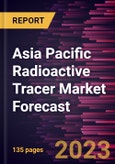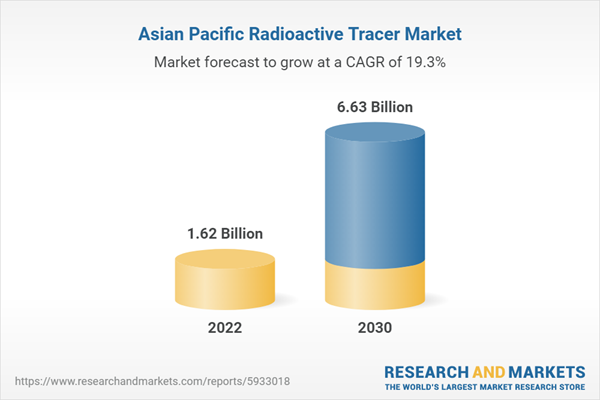Rising Prevalence of Chronic Diseases fuel the Asia Pacific Radioactive Tracer Market
Increasing aging population, changing social behavior, rising adoption of a sedentary lifestyle, and accelerating urbanization are the key factors boosting the prevalence of obesity and other chronic diseases such as diabetes. Further, studies have long established that genes can cause chronic conditions such as cardiovascular disease (CVD), diabetes, obesity, Alzheimer's disease (AD), and depression.CVDs, such as atherosclerosis, angina pectoris, and acute myocardial infarction, caused due to hectic lifestyles have become significant causes of mortality worldwide. As per the data provided by the WHO, CVDs are the predominant cause of death worldwide, recording estimated 17.9 million deaths each year. Diabetes is a life-threatening chronic disease with no functional cure. Diabetes of all types can lead to various complications in different body parts and increase the overall risk of premature death. Heart attack, stroke, kidney failure, leg amputation, vision loss, and nerve damage are among the major complications associated with diabetes. The disease prevalence will likely increase by nearly 35% during the forecast period.
Thus, an effective examination is a must for properly treating chronic diseases; hence, nuclear substances are used for diagnosis and examination purposes. These nuclear substances are used in diagnostic tests such as positron emission tomography (PET) and single-photon emission computerized tomography (SPECT) to diagnose chronic diseases such as neurological, cardiovascular, chronic lung, and chronic kidney diseases. the availability of several radiotracer across the globe makes it selection easy depending on the type of disease and its prognosis. Thus, the increasing incidences of chronic diseases are surging the demand for radioactive tracer, positively favoring market expansion.
Asia Pacific Radioactive Tracer Market Overview
The Asia Pacific radioactive tracer market is segmented into Australia, China, India, Japan, South Korea, and the Rest of Asia Pacific. The market in the region is likely to continue to grow at the fastest rate during the forecast period owing to factors such as the development of new research facilities, the rise in the geriatric population and significant evolution of hybrid systems with technological advancement in the field of imaging.Asia Pacific Radioactive Tracer Market Revenue and Forecast to 2030 (US$ Million)
Asia Pacific Radioactive Tracer Market Segmentation
The Asia Pacific radioactive tracer market is segmented based on tracer type, test type, end user, application, and country. Based on tracer type, the Asia Pacific radioactive tracer market is segmented into technetium-99m & Tc-97m, iodine-131, iron-59, lutetium-171, rubidium (Rb-82) chloride & ammonia (N-13), scandium-46, seaborgium-269, hassium-269, Gallium citrate Ga 67, Prostate-Specific Membrane Antigen (PSMA) (Ga-68), FDDNP (F-18) & FDOPA (F-18), phosphorus-32 & chromium-51, thallium-201, F-18 FDG, F-18 FAPI, Ga-68 FAPI, F-18 PSMA, DOTATOC/DOTANOC/DOTATATE (Ga-68), and others. The others segment held the largest market share in 2022.Based on test type, the Asia Pacific radioactive tracer market is segmented into PET, SPECT, and others. The SPECT segment held the largest market share in 2022.
Based on end user, the Asia Pacific radioactive tracer market is segmented into hospitals & clinics, diagnostic centers, academic & research institutes, and others. The hospitals & clinics segment held the largest market share in 2022.
Based on application, the Asia Pacific radioactive tracer market is segmented into oncology, pulmonary, neurology, cardiology, and others. The oncology segment held the largest market share in 2022.
Based on country, the Asia Pacific radioactive tracer market is segmented into China, Japan, India, Australia, South Korea, and the Rest of Asia Pacific. China dominated the Asia Pacific radioactive tracer market share in 2022.
Rotem Industries Ltd, Invicro LLC, Cardinal Health Inc, Newcastle University, Novartis AG, Curium, and IBA Radiopharma Solutions are some of the leading players operating in the Asia Pacific radioactive tracer market.
Table of Contents
Executive Summary
At 19.3% CAGR, the Asia Pacific Radioactive Tracer Market is Speculated to be worth US$ 6,629.61 million by 2030.According to this research,, the Asia Pacific radioactive tracer market was valued at US$ 1,615.80 million in 2022 and is expected to reach US$ 6,629.61 million by 2030, registering a CAGR of 19.3% from 2022 to 2030. Rising prevalence of chronic diseases and increasing use of nuclear imaging techniques are the critical factors attributed to the Asia Pacific radioactive tracer market expansion.
One of the primary opportunities within the radioactive trace market in Asia Pacific lies in the healthcare and diagnostics sector. The emerging economies of region such as China, India, Malaysia, Thailand, Indonesia, and Vietnam, are experiencing high growth and development in their healthcare infrastructure. The region’s vast and rapidly growing population, coupled with and increasing focus on healthcare infrastructure development, makes it a fertile ground for the application of radioactive tracers. Despite being highly preventable, cardiovascular disease (CVD) remains the leading cause of mortality in Asia-Pacific. CVD was responsible for an estimated 9.85 million fatalities in SEARO and WPRO in 2019, accounting for 45% of all NCD deaths in these regions. Furthermore, after CVD, cancer is the second biggest cause of mortality in the Asia-Pacific area. In 2019, cancer was responsible for an estimated 5 million deaths (or 24% of total NCD fatalities) in Asia-Pacific. Furthermore, there were 821.8 million newly diagnosed neurological illnesses globally in 2019: 227 million in the WHO South-East Asia region and 178.6 million in the WHO Western Pacific region. Radioactive tracers play a significant role in diagnostic imaging techniques such as Positron Emission Tomography (PET) and single Phonton Emission Computed Tomography (SPECT). As Asian countries advance their healthcare systems, there is rising demand for precise and early disease detection. Radioactive tracers, which allow for the visualization of molecular and cellular processes within the body, are instrumental in detecting various medical conditions, including cancer, cardiovascular diseases, and neurological disorders. They offer the advantage of early diagnosis and staging, leading to more effective treatment and improved patient outcomes. Moreover, the increasing awareness among both healthcare professionals and the general public about the benefits of nuclear medicine and molecular imaging is driving the demand for radioactive tracers. This trend is further supported by a growing middle-class population with greater access to healthcare services. Thus, the radioactive tracer market in “region’s name” is poised to experience substantial growth as it becomes an integral component of advanced medical diagnostics and patient care.
On the contrary, short shelf-life of radioactive tracer hurdles the growth of Asia Pacific radioactive tracer market.
Based on tracer type, the Asia Pacific radioactive tracer market is categorized into technetium-99m & Tc-97m, iodine-131, iron-59, lutetium-171, rubidium (Rb-82) chloride & ammonia (N-13), scandium-46, seaborgium-269, hassium-269, Gallium citrate Ga 67, Prostate-Specific Membrane Antigen (PSMA) (Ga-68), FDDNP (F-18) & FDOPA (F-18), phosphorus-32 & chromium-51, thallium-201, F-18 FDG, F-18 FAPI, Ga-68 FAPI, F-18 PSMA, DOTATOC/DOTANOC/DOTATATE (Ga-68), and others. The others segment held 62.1% market share in 2022, amassing US$ 1,002.62 million. It is projected to garner US$ 3,885.24 million by 2030 to expand at 18.5% CAGR during 2022-2030.
Based on test type, the Asia Pacific radioactive tracer market is categorized into PET, SPECT, and others. The SPECT segment held 44.6% share of Asia Pacific radioactive tracer market in 2022, amassing US$ 720.14 million. It is projected to garner US$ 2,917.97 million by 2030 to expand at 19.1% CAGR during 2022-2030.
Based on end user, the Asia Pacific radioactive tracer market is categorized into hospitals & clinics, diagnostic centers, academic & research institutes, and others. The hospitals & clinics segment held 70.2% share of Asia Pacific radioactive tracer market in 2022, amassing US$ 1,134.15 million. It is projected to garner US$ 4,658.68 million by 2030 to expand at 19.3% CAGR during 2022-2030.
Based on application, the Asia Pacific radioactive tracer market is categorized into oncology, pulmonary, neurology, cardiology, and others. The oncology segment held 61.0% share of Asia Pacific radioactive tracer market in 2022, amassing US$ 985.25 million. It is projected to garner US$ 3932.21 million by 2030 to expand at 18.9% CAGR during 2022-2030.
Based on country, the Asia Pacific radioactive tracer market has been categorized into China, Japan, India, Australia, South Korea, and the Rest of Asia Pacific. Our regional analysis states that China captured 29.3% share of Asia Pacific radioactive tracer market in 2022. It was assessed at US$ 472.62 million in 2022 and is likely to hit US$ 1,912.64 million by 2030, exhibiting a CAGR of 19.1% during 2022-2030.
Key players operating in the Asia Pacific radioactive tracer market are Rotem Industries Ltd, Invicro LLC, Cardinal Health Inc, Newcastle University, Novartis AG, Curium, General Electric Co, and IBA Radiopharma Solutions, among others.
Companies Mentioned
- Rotem Industries Ltd
- Invicro LLC
- Cardinal Health Inc
- Newcastle University
- Novartis AG
- Curium
- General Electric Co
- IBA Radiopharma Solutions
Table Information
| Report Attribute | Details |
|---|---|
| No. of Pages | 135 |
| Published | December 2023 |
| Forecast Period | 2022 - 2030 |
| Estimated Market Value in 2022 | 1.62 Billion |
| Forecasted Market Value by 2030 | 6.63 Billion |
| Compound Annual Growth Rate | 19.3% |
| Regions Covered | Asia Pacific |
| No. of Companies Mentioned | 8 |









